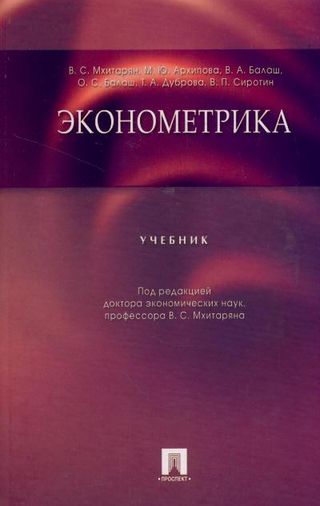?
Множественная линейная модель регрессии в условиях мультиколлинеарности
Гл. 4. С. 72–92.
In book

Mkhitarian V., Arkhipova M., Балаш В. А., Балаш О. С., Dubrova T. A., Sirotin V. М.: Проспект, 2014.
Mkhitarian V., Ручинская Л. В., В кн.: Статистика как средство международных коммуникаций: Материалы международной научно-практической конференции. СПб.: Издательство Нестор-История, 2014. С. 235–238.
Сборник содержит тезисы и полные тексты докладов, представленных на Международной научно-практической конференции "Статистика как средство международных коммуникаций". Освещаются основные направления развития статистического образования и российской государственной статистики в связи с интеграцией России в международную организацию. Рассматриваются задачи современной статистики в области измерения человеческого потенциала, формирования рынка труда, демографического воспроизводства, измерения национального богатства, факторов модернизации и ...
Added: December 20, 2014
Sirotin V., В кн.: Эконометрика: учебник. М.: Проспект, 2015. Гл. 4 С. 72–92.
Рассматриваются виды мультиколлинеарности и ее последствия, методы диагностики мультиколлинеарности. Наряду с отбором наиболее информативных признаков и удаления дублирующих характеристик представлены методы перехода к в ортогональное признаковое пространство и регуляризации модели без изменения состава регрессоров. ...
Added: March 10, 2017
Melville A. Y., Mironyuk M., Полис. Политические исследования 2020 № 6 С. 41–61
In this article, we present the results of the development of the “Political Atlas of the Modern World”
(“Atlas 1.0”) project. “Atlas-1.0” was implemented more than ten years ago by scholars of the MGIMO
University with the support of the Institute of Public Projects and the “Expert” magazine. Development
of five complex indices – of stateness, external and ...
Added: December 1, 2020
Aistov A., Прикладная эконометрика 2018 Т. 50 С. 23–42
In this paper we compare age-earnings profiles between generations. Our empirical estimates are based on the Russia Longitudinal Monitoring Survey of HSE (RLMS-HSE), 1994–2015. Using intrinsic estimator, we overcome age-period-cohort problem inherent in Mincer-type earnings functions. Comparison presented in the work revealed that some male generations’ income is less than that of the young cohorts ...
Added: July 19, 2018
Aistov A., В кн.: Системное моделирование социально-экономических процессов: труды 41-ой международной научной школы-семинара, г. Нижний Новгород, 30 сентября – 4 октября 2018 г. Воронеж: Истоки, 2018. С. 296–299.
Multicollinearity prevents to indentify marginal effects of cohort, age, and period regressors including them all together in Mincerian type earnings function. This is well-known age-period-cohort (APC) problem. Intrinsic estimator helps us to compare age-earnings profiles of several generations in Russia, 1994–2016. Comparison presented in this paper revealed that some male generations’ income is less than ...
Added: January 28, 2020